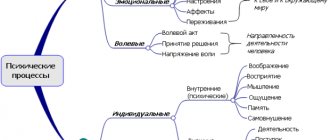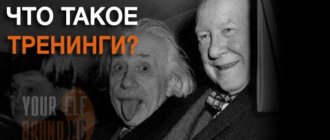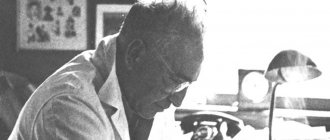The development of psychology in the USSR occurred rapidly and was based on the methodology of Marxism. Lev Vygotsky, an iconic Soviet psychologist, became one of the key figures in Russian psychology thanks to his active support of Marxist ideas. Vygotsky's contributions to psychology are characterized primarily by the founding of the Marxist research tradition that later became known as cultural-historical theory. Vygotsky also studied the characteristics of the child’s cognitive development and pedology, combining the research results into a system of knowledge about the process of formation of the child’s psyche.
Vygotsky's main ideas about personality, child upbringing, and the role of pedagogy
Educational psychology is a branch of psychological science. She studies the features of interaction between student and teacher, the conditions for personality formation in the learning process, and the patterns of mental activity. The formation of educational psychology in the USSR was largely due to the research of Lev Semenovich Vygotsky.
Vygotsky identified the main factors of a child’s mental development:
- social development situation;
- mental neoplasms;
- leading activity.
The social situation is understood as the external and internal conditions of mental development that shape the child’s attitude to the world around him.
Cultural-historical theory is the author’s main work, in which he examines the theory of mental development. In his opinion, one should distinguish between higher (developed as a result of the historical development of society) and lower (appearing in the process of evolution) psychological functions. Vygotsky noted that the main difference between functions is arbitrariness. The lower impulses of the psyche cannot be controlled, but a person consciously controls the higher ones.
The process of reproducing the highest function consists of a chain: stimulus - stimulus-means - reaction. By stimulus-means or sign, Vygotsky understood a method of controlling behavior. Signs are directed inward; a person creates them for himself. Through signs you can switch attention, regulate behavior, and make decisions. Such means include casting lots, counting on fingers, a hidden condition and other methods that help make a choice between several options.
Vygotsky became the founder of Russian psycholinguistics, studying the relationship between thinking and speech. He notes that thinking and speech develop in parallel, but not together. Initially, the development of intelligence occurs in the pre-speech phase, at the same time speech develops in the pre-intellectual phase. From the moment of development of active speaking, speech and thinking intersect. Speech becomes intellectual, and thinking becomes based on speech. The child’s speech functions become the basis for the work of thinking.
Yanko Slava (Fort/Da Library) || https://yanko.lib.ru || Consciousness as a problem in the psychology of behavior Library of World Psychology L.S. Vygotsky PSYCHOLOGY OF HUMAN DEVELOPMENT
Moscow “sense”
2005
BBK 88.4 V 92
Artistic design and original layout A. Bondarenko
Vygotsky L.S.
In 92 Psychology of human development.
- M.: Publishing house Meaning; Eksmo Publishing House, 2005. - 1136 p., ill. — (Library of World Psychology). ISBN 5-699-13728-9
Lev Semenovich Vygotsky (1896-1934) - an outstanding scientist, thinker, classic of Russian
psychology. His legacy is enormous (more than 270 works), and his ideas are inexhaustible, original and still
relevant. He had a huge influence on the development of domestic and world psychology. Famous
American philosopher S. Toulmin called him the Mozart of psychology. Working in difficult conditions, for
in a very short time he managed to make an important contribution to the psychology of art, general psychology,
child and educational psychology, patho- and neuropsychology, methodology of psychology, defectology
and pedagogy.
His works represent the best pages of Russian psychological science. The ideas of Vygotsky and his
schools serve as the basis for the scientific worldview of new generations of psychologists throughout Russia.
It is for them that this book was prepared.
New edition of works by L.S. Vygotsky prepared taking into account the comments and wishes of the team
teachers of the Faculty of Psychology of Moscow State University. This includes all work included in the training
plans and necessary in the educational process; everything that the teachers recommend. This edition
supplemented with rare and unique materials that were not even included in the well-known six-volume collection
works of Vygotsky.
This book combines works on general psychology, the second will include works on age and
educational psychology.
BBK 88.4
ISBN 5-699-13728-9
© GL. Vygotskaya, E.E. Kravtsova, 2005
© Compilation. Introductory article. A.A. Leontyev, 2005
© Design. A. Bondarenko, 2005
© Eksmo Publishing House LLC, 2005
Preface
The twentieth century in Russia is rich in world-class thinkers. This is Vladimir Ivanovich Vernadsky, the creator of the concept of the noosphere. These are Pavel Aleksandrovich Florensky, Mikhail Mikhailovich Bakhtin, Gustav Gustavovich Shpet, Yuri Mikhailovich Lotman, Nikolai Aleksandrovich Berdyaev. A.F. can be added to this list. Loseva, and N.O. Lossky, and AA Ukhtomsky, and PO Yakobson. Such a constellation of talents would be a credit to any country in any historical era.
Lev Semenovich Vygotsky fits organically into this series.
His fate resembles the fates of other people on our list. Of course, he did not die in captivity, like Florensky or Shpet, and was not forcibly forced into exile, like Berdyaev and Lossky. Vygotsky died of natural causes in the midst of a rapid creative rise that has no analogues in the scientific biographies of other scientists. Maybe he was lucky - he would hardly have survived 1937, especially considering that at the end of 1936, after the “fateful” resolution of the Central Committee of the All-Union Communist Party of Bolsheviks “On pedological perversions in the system of People’s Commissariat of Education,” the already dead Vygotsky became the main target devastating criticism - what is the famous brochure by E.I. worth? Rudneva “On the pedological perversions of L.S. Vygotsky." Most of his books were confiscated, his name was crossed out by censors from the proofs, and it was ridiculous to even think about reprinting his works. As well as about the publication of manuscripts - and among them were such wonderful books as “The Psychology of Art”; “The Historical Meaning of the Psychological Crisis”, “Tool and Sign in the Development of the Child” (reprinted in this volume); “The Teaching of Emotions”; finally, a small but full of ideas work “Concrete Human Psychology” (it was also included in our volume). All this is now available to readers, although many of Vygotsky’s manuscripts and his publications scattered in little-known journals and collections are still little known or completely unknown.
1 This preface is based on the text of the article: AA Leontiev.
Key ideas of L.S. Vygotsky’s contribution to world psychology of the 20th century. // Psychological Journal, 2001, volume 22, no. 4. 5
1956 brought Vygotsky the restoration of his real place in Soviet psychology, and then world fame. In the humanities, the “citation index” criterion, which is widespread in scientific studies, is hardly applicable: but if an analysis of psychological publications in the West in the last decades of the last century were carried out from this point of view, we would see that even in a country “closed” from the European (not to mention already about Soviet) psychology in America, it was considered indecent for a psychologist involved in child, educational, and general psychology not to mention the name of Vygotsky. Another question is that Vygotsky was perceived in the West, especially in the USA, not quite as he really was. He was diligently repainted either as a neobehaviorist, or as a cognitivist, or as an existential psychologist...
However, Vygotsky’s contribution to psychology, and to the humanities in general, was so great and multifaceted that it was possible to take various ideas from him without even seriously violating the integrity of his concept. This is what happened in the last decades of the twentieth century, not only in other countries, but also in our own country. There are now dozens of books about Vygotsky. But in each of them he is depicted differently, the way one or another author perceives him. Vygotsky AB Brushlinsky or E.A. Budilova is not too similar to Vygotsky in the books of V.P. Zinchenko, A.A. Bubbles, J. Vercha. M.G. Yaroshevsky or A. Kozulin do not agree with J. Valsiner in their assessments. N. Veresov, A.G. Asmolov or the author of these lines.
Therefore, by the way, it is very difficult to write about the role of Vygotsky in world science of the 20th century: any judgment will seem subjective and “partisan” to someone. Nevertheless, in this article we would like to try to go beyond our own interpretation of Vygotsky and his scientific path and highlight the most important thing that is beyond doubt (and if someone does not agree with this, then this is, as V. used to say. B. Shklovsky, already a fact of his own biography, and not the biography of Vygotsky).
1 We will give here the output of the most accessible books about Vygotsky (or partially dedicated to him), published in recent decades in Russian: Scientific creativity of L.S. Vygotsky and modern psychology.
M., 1981; Brushlinsky AB Cultural-historical theory of thinking. M., 1968; Wertsch J. Voices of Reason. M., 1996; Vygodskaya G.L., Lifanova T.M. Lev Semenovich Vygotsky. M., 1996; Zinchenko V.P., Morgunov E.B. A developing person. Essays on Russian psychology. M., 1994; Levitin K.E. People are not born with personality. M., 1990; Leontiev A.A. L.S. Vygotsky. M., 1990; Leontyev AA Active mind. M., 2001; Morozov S.M. Vygotsky's dialectics. M., 2002; Bubbles AA Vygotsky's cultural-historical theory and modern psychology. M., 1986; Yaroshevsky M.G. L.S. Vygotsky in search of a new psychology. St. Petersburg, 1993. In 2003, “L. S. Vygotsky’s Dictionary” was published by the Smysl publishing house. 6
Let's start with the fact that Vygotsky was a Marxist (as he himself said, a materialist in psychology), and this largely determined his scientific views. When we talk about Vygotsky’s Marxism, we do not at all mean that vulgarized pseudo-Marxism, which, starting in 1930, entered the official Soviet ideology as its component (and the “peak” of which was the famous
fourth chapter in Stalin’s “Short Course”). That pseudo-Marxism, which was propagated by academicians Yudin and Mitin under the name of “Marxist-Leninist philosophy” and taught in any university in the Soviet Union, had nothing in common with the true philosophy of Marx - and it is no coincidence that the latter’s early works, including the remarkable “Economic and Philosophical Manuscripts” 1844”, became available to the general reader only in the same 1956... No, Vygotsky was a genuine dialectical Marxist, objectively joining the group of A.M. Deborin, who was condemned by Stalin in 1930 for “right deviation” (the same eminent author attached the famous label “Menshevik idealists” to the Deborinites, the meaning of which remained unclear).
One might think that there were such Marxists in the 20s and 30s. there were many. Of course, there were plenty of people who called themselves Marxists. But there were only a few educated philosophers and psychologists - the majority repeated memorized formulas, not being able to comprehend them and successfully apply them in specific scientific activities. (Vygotsky had every reason to note in “Historical Crisis”: “It’s not difficult to be a materialist in physiology—try being one in psychology.”) Among them, in addition to Vygotsky, one can name Pavel Petrovich Blonsky (with whom Vygotsky studied at the A.L. . Shanyavsky); Sergei Leonidovich Rubinstein, who accomplished the almost unthinkable - not knowing the then unpublished (in the 20s) philosophical works of Marx and Engels, he took an independent step from Hegel to Marxism; Mikhail Yakovlevich Basov... And it is no coincidence that these are the names - Vygotsky, Blonsky, Rubinstein, Basov - that we call when we are looking for the origins of the so-called activity approach in Soviet psychology. However, to a certain extent, Dmitry Nikolaevich Uznadze, who was formed (like Rubinstein) in the ideological space of Hegel, can also be included in this group of psychologists; I.V. Imedadze convincingly showed that all the essential characteristics of what Uznadze called “behavior” are identical to what Russian psychologists associate with the concept of activity.
However, not all scientific biographers of Vygotsky are united here. Some of them do not believe that Vygotsky had an idea of activity at all, at least in the form in which we find it in A.N. Leontyeva, P.Ya. Galperina, D.B. Elkonin, AB Zaporozhets (Vygotsky school) or S.L. Rubinstein. 7
Of course, one can argue about whether A.N.’s “psychological theory of activity” was Leontiev and his collaborators, and then colleagues, a direct continuation and development of Vygotsky’s activity ideas (although the study of scientific primary sources convinces us that there was): but that Vygotsky repeatedly expressed such ideas is absolutely certain - they can be traced in all the main works of Lev Semenovich, in including those published in this volume.
These ideas clearly go back to Hegel and Marx. It is the latter who owns the thesis about “the uniqueness of man’s active labor adaptation of nature to himself, as opposed to the passive adaptation of animals to the environment” (L.S. Vygotsky. Collected works, vol. 1, p. 75; further references to this publication are given in text in the following form: 1.75). In his polemic with J. Piaget, the idea is clearly stated that Piaget erroneously deduces the child’s thinking and development “from the pure communication of consciousnesses without any consideration of the child’s social practice aimed at mastering reality” (2.75). The monograph “Tool and Sign in the Development of the Child” is especially characteristic in this regard: the concept of activity is already used here. The child, writes Vygotsky, “enters the path of cooperation, socializing practical thinking by sharing his activities with another person... Socialization of practical intelligence leads to the need to socialize not only objects, but also actions” (6, 31). And further: “The child’s own activity is aimed at a specific goal...” The presence of a sign and speech allows one to “imagine moments of future action in a given situation...”. This “creates conditions for a completely new nature of the connection between the elements of the present and the future, creates a completely new psychological field for action, leading to the emergence of the functions of forming an intention and a pre-planned target action” (6.49).
So, the first thing that Vygotsky introduced into Soviet and world psychology was a completely clear psychological concept of activity.
Let us emphasize once again: in this preface we do not touch upon the further fate of this concept.
In the same way, we do not claim that it was Vygotsky alone who developed the philosophical
concept of activity as the methodological basis of Soviet psychology: here the priority, apparently, belongs to Rubinstein (although these considerations of his from the 1920s remained in the manuscript or (1922 article) were practically inaccessible).1
As for the structure of activity, it represents 1 See: AB Brushlinsky. S.L. Rubinstein is the founder of the activity approach in modern science.// Sergei Leonidovich Rubinstein: Essays, memoirs, materials. M., 1989; A.A. Leontyev. Active mind. M., 2001. 8
Of particular interest is what Vygotsky wrote about the stages of speech production (and what gave us reason to talk about him as the “first psycholinguist”)1.
Already from the quoted words of Vygotsky from “Tool and Sign” it is clear that his understanding of activity
organically connected with the idea of iconicity and a certain interpretation of the psychological role of language. V.V. Davydov was absolutely right when he emphasized that it is impossible to understand the origin of the activity of an individual person without revealing its original connections with communication and with sign-symbolic systems. It was Lev Semenovich who was the first to see that this was impossible. And I tried to build a psychological concept where the sign (word), society (communication) and activity would act in theoretical unity.
He succeeded to a large extent. There are several significant points in his approach.
First: a clear analysis of meaning as a psychological concept.
It was with Vygotsky that the concept of meaning, which until then existed only in the space of logic, linguistics and semiotics, acted as an equal in the system of concepts of general psychology and developmental psychology.
Second: the dynamic, procedural nature of meaning.
For Vygotsky, meaning appears as “the internal structure of a sign operation” (1, 160), as a path from thought to word, etc.
Third: the concept of objective meaning.
It was perhaps Vygotsky who was the first to outline it - although Rubinstein, Uznadze, Leontyev have similar thoughts, but they belong to a later time.
Fourth: the semantic structure of consciousness.
(The concept of meaning appears here in Vygotsky as “that which is included in the meaning (the result of meaning), but is not assigned to the sign” (1.165)).
Fifth: the social nature of meaning (sign).
“... Every symbolic activity of a child was once a social form of cooperation” (6.56).
Sixth: sign, meaning as a unity of communication and generalization.
Seventh and most importantly: the word and action are combined into a single psychological system.
Lev Semenovich shows exactly how they are combined using material from a children's game. (See his “notes” about the game, published by D.B. Elkonin in his 1978 book “Psychology of the Game” and reprinted in this volume). If we try to briefly formulate his position, it is as follows: the emergence of language (speech) rebuilds the system of displaying an object - 1 See AA Leontiev. Lev Semenovich Vygotsky as the first psycholinguist. // News of the Academy of Pedagogical and Social Sciences. Issue 1. Problems of modern psychology. M. - Voronezh, 1996. 9
of a new world in the child’s psyche. The naming of an object and the appearance of a verbal meaning introduces a new principle into the organization of consciousness. The objectivity of perception is directly determined by language (speech). On the one hand, the construction of human consciousness is associated with the development of instrumental activity. But, on the other hand, on the basis of verbal meanings that become objective, a system of meanings arises, which directly constitutes consciousness. At the same time, the word is bipolarly oriented, settling with meaning in thought and meaning in things. Thanks to this, it is possible to operate with “pure values” outside of direct practical action, i.e. thinking, theoretical activity in general.
Bottom line: the new way of operating with things and objects is based on verbal meaning, the word as a tool of social contact and communication. At the same time, the development of this method is impossible without practice, without relying on the real properties of things.
The Kharkov students considered this concept “word-centric,” and in principle they were apparently right. The discrepancy between the “Kharkovites” and Vygotsky was most clearly formulated by A.N. Leontiev in the recently published manuscript “The Doctrine of the Environment in the Pedological Works of L.S. Vygotsky” (“Questions of Psychology”, 1998, No. 1): “...the position of L.S. Vygotsky’s idea that consciousness is a product of a child’s verbal communication in the conditions of his activity in relation to the external reality surrounding him, it is necessary to turn it around: the child’s consciousness is a product of his human activity in relation to objective reality, taking place in the conditions of language, in the conditions of verbal communication” ( p. 122).
Vygotsky’s understanding of the role of language (sign) in the formation of human consciousness and activity described above implements his more general thesis about the cultural-historical nature of the human psyche.
(Here I would like to emphasize that the term “cultural-historical” itself can and is used in two ways. Firstly, to designate a certain period in the development of the views of Vygotsky and his school - the period to which Lev Semenovich’s article refers. “The Problem of Cultural Development child", written jointly with A.R. Luria, the book "Etudes on the History of Behavior" and the monograph by A.N. Leontiev "Development of Memory". Secondly, in a broader sense, when referring to Vygotsky's general idea about the role of historically developing human culture in the formation and functioning of the individual psyche - it is in this sense that A.G. Asmolov speaks about the cultural-historical approach in a number of his works in recent years.)
The above does not limit the significance of Vygotsky for the psychology of the 20th century.
And the next problem, inextricably linked with the problems of activity and sign 10
(language, meaning) outlined above, is the role of social, collective activity in the mental development of the child.
To reveal Vygotsky’s approach to this problem, it is necessary first of all to understand what he meant by the very concept of mental development.
It is characterized by an understanding of “development as a process characterized by the unity of the material and mental aspects, the unity of the social and personal as the child ascends the stages of development” (4.248). Periods of smooth, almost imperceptible internal changes in the child’s personality are replaced by periods of sudden shifts and conflicts. Microscopic changes, “accumulating to a certain limit, are then abruptly detected in the form of some age-related neoplasm” (4.249). As you know, Vygotsky identifies 5 such leaps or “crises”: the newborn crisis, the one-year crisis, the 3-year crisis, the 7-year crisis and the 13-year crisis. At the beginning of each new age period, a specific “social situation of development” develops. This is “a completely original, specific for a given age, exclusive, unique and unrepeatable relationship between a child and the reality around him, primarily social” (4.258). It is this social reality that is the “main source of development.”
We determine by tests or other means the level of mental development of the child. But at the same time, it is completely insufficient to take into account what the child can and can do now,
what is important is what he can and will be able to do tomorrow, what processes, even if not completed today, are already “ripening.” “Just as a gardener, when determining the types of crops, would do wrong by counting only the number of ripened fruits in the garden and failing to assess the condition of the trees that have not yet produced ripe fruit, a psychologist who limits himself to determining what is ripe, leaving aside what is ripening, will never can get some true and complete idea of the internal state of the entire development...” (4.262).
A child can solve a problem completely independently, and usually only such an independent solution is taken into account.
But it may also be that the child needs a guiding question, an indication of the method of solution, etc. to solve the problem. Then imitation arises, of course, “not mechanical, automatic, meaningless, but intelligent, based on understanding, the imitative performance of some intellectual operation.” Imitation is anything “that a child cannot do on his own, but that he can learn or do with guidance or cooperation...” (4.263). But “what today a child can do in cooperation and under guidance, tomorrow he becomes able to do independently
. ...By examining what a child is able to do on his own, we are examining the development of yesterday. By exploring what a child is capable of accomplishing in cooperation, we determine the development of tomorrow” (4.264).
The very thing that a child can now do only in cooperation, and tomorrow on his own - this is the famous zone of proximal development.
This zone is created by training, which should “run ahead of development.” It “sets in motion a whole series of internal development processes that are now still possible for the child only in the sphere of relationships with others and cooperation with friends, but which, going through the internal course of development, then become the internal property of the child himself” (L.S. Vygotsky Mental development of a child in the learning process (M.: L.: 1935, p. 16; we reproduce this book in full in this volume).
For a psychologist (and, of course, a teacher), three points are important here.
First. Each mental function, writes Vygotsky, appears on stage twice. First as a collective, social activity, and then as a child’s internal way of thinking. Between these two “exits” lies the process of internalization, or, as Vygotsky liked to say, “growing” the function inward.
Second. If so, it means that the process of learning (and education) itself must be a collective activity. (It was in this direction that many pedagogical searches of the 20-30s went, including A.C. Makarenko).
And third. The meaning of the teacher’s work is to direct and regulate the activities of students through collective activity, through organizing the cooperation of students with each other and teachers with students.
It is quite obvious that this concept of Vygotsky is the deep theoretical and psychological basis of the pedagogy of cooperation and developmental education. AND
This is one of Vygotsky’s main merits not only to general and educational psychology, but also to all Russian education.
Let's go back briefly to Vygotsky's reasoning about the dialectics of child development, and pay attention to one of his formulations. He says that new formations of critical (conflict) periods are not preserved in the future unchanged “and are not included as a necessary component in the integral structure of the future personality” (4.254).
What is this integral personality structure for Vygotsky?
Of course, the very concept of personality existed in psychology
even before Vygotsky . But his understanding of personality was in some ways unique.
Firstly, for Vygotsky, “personality is the primary thing that is created together with higher functions.”
And these functions themselves
are “transferred into the personality, internalized relations of the social order,
the basis of the social structure of the personality….
Individual personal is not contra, but the highest form of sociality" (L.S. Vygotsky. Concrete human psychology. // Bulletin of Moscow State University, Psychology series, 1986, No. 1, p. 59, 54; work reproduced in this volume). (Here there is a lot in common with the thoughts of S.L. Rubinstein of those years). In other words, personality for Vygotsky is the basis around which the entire human psyche is built, including activity and consciousness; this is something in a particular person that is a direct product, the crystallization of his social life. “Since a person thinks,
let us ask:
what kind of person...
With the same laws of thinking... the process will be different, depending on
what kind
of person it occurs in” (ibid., 59).
Secondly, it is no coincidence that the cited article by Vygotsky is called “Concrete Human Psychology.” This is the term of J. Politzer, a French Marxist psychologist, from whom another important concept was taken - “drama”. Vygotsky generally valued Politzer very highly. The idea of personality as a drama is important because along with it the idea of dialectics, internal struggle, complex dynamics, fusion and mutual transitions of mental processes, functions and states invades the psychology of the individual.
Thirdly, the world for Vygotsky is not - to use the famous expression of J. Bruner - a “world of symbols”: cognitive processes are only part of the processes of internalization; they are subordinated to the personality that defines and regulates them.
In strictly psychological terms, personality for Vygotsky is, using his terminology, a dynamic semantic system, including motivational, volitional, emotional processes, dynamics of action and dynamics of thought. “In the process of social life... new systems, new alloys of mental functions arise, unities of a higher order arise, within which special patterns, interdependencies, special forms of connection and movement prevail” (6.328).
For Vygotsky, such an alloy, such a unit of a higher order, is the personality as a unity of intellect and affect.
Their attitude is “not a thing, but a process.” (And, most likely, the shift in emphasis in Vygotsky’s last works from activity to this unity of intellect and affect, which initially caused a protest from his Kharkov students, meant precisely the transition to the personal paradigm - the first to show that he was right next page >>
The formation of psychology in Russia and the USSR: Vygotsky’s contribution
Lev Vygotsky's work in the field of psychology began in 1922, from the moment he began working at the Gomel Technical School. Within a year, he managed to create a laboratory at the technical school and conduct the first experiments, collect the results and prepare them for presentation at a congress of psychoneurologists. Participation in the congress allowed Vygotsky to enroll in graduate school at the Moscow Institute of Experimental Psychology and become the head of a subsection in the department of Social and Legal Protection of Minors. The scientist studied the features of raising children with mental retardation, hearing and vision impairments.
After defending his dissertation, Vygotsky delved into the study of pedagogy. At the first pedological congress, he presented two reports on the development of difficult-to-educate children and the instrumental method in pedology. Based on the reports, he developed the first version of the theory of child development and published four books devoted to problems of development and education.
Together with his colleague and follower Luria, he founded the Vygotsky Circle, a project to study the highest forms of mental activity. From 1930 to 1934 he spoke at conferences, took part in international expeditions, presented a report and a draft book on thinking and speech. The book was published after the author's death.
The scientists who were part of the circle of researchers continued their work even after the death of the professor, preserving and popularizing the results of his research.
Life and work of a domestic scientist
The biography of this famous person begins in 1896 - on November 17, a boy named Lev Vygotsky was born in one of the large families in the city of Orsha. A year later, the Vygotsky family moves to Gomel, where the boy’s father (a former bank employee) opens a library.
The future innovator studied science at home as a child. Lev, like his brothers and sisters, was taught by Solomon Markovich Ashpiz, whose teaching methods differed significantly from traditional ones. Practicing Socratic teachings, which were hardly used in the educational programs of that time, he established himself as a very remarkable personality.
By the time Vygotsky needed to enter higher education, he already knew several foreign languages (including Latin and Esperanto). Having entered the medical faculty of Moscow University, Lev Semenovich soon submitted a request to be transferred to another faculty to study jurisprudence. However, while mastering jurisprudence simultaneously at two faculties of different educational institutions, Vygotsky nevertheless came to the conclusion that the legal profession was not for him, and completely delved into the comprehension of philosophy and history.
The results of his research were not long in coming. Already in 1916, Lev wrote his first creation - an analysis of the drama “Hamlet” by William Shakespeare. The author later presented the work, which took up exactly 200 pages of handwritten text, as a thesis.
We recommend: Pedology is
Like all subsequent works of the Russian thinker, the innovative two-hundred-page analysis of Shakespeare's Hamlet aroused keen interest among specialists. And it’s not surprising, because in his work Lev Semenovich used a completely unexpected technique that changed the usual understanding of the “tragic story of the Danish prince.”
A little later, as a student, Lev began to actively write and publish literary analyzes of works by Russian writers - Andrei Bely (B.N. Bugaev), M.Yu. Lermontov.
L.S. Vygotsky graduated from universities in 1917 and after the revolution moved with his family to Samara, and then to Kyiv. But after some time they all return to their hometown, where young Vygotsky gets a job as a teacher.
In a brief summary, the thinker’s life upon returning to his homeland can be summarized in a few sentences (although Wikipedia offers a much more detailed version): he works in schools, teaches at technical schools and even gives lectures, trying himself as an editor in a local publication. At the same time, he heads the theater and art education departments.
However, the young teacher’s serious practical work in the teaching and scientific fields began around 1923-1924, when at one of his speeches he first spoke about a new direction in psychology.
Personality development in the context of pedagogy and psychology
Vygotsky’s main interest was the problems of the development of the psyche in ontogenesis, the formation of personality. For the normal formation of higher mental functions, the timely development of brain structures is not enough. The study of the psychological state of children who grew up in conditions that do not imply social adaptation showed that for the full development of the individual, a social situation of development is necessary. By this term, Vygotsky understood the relationship between the child and society. The type of interaction determines the course of development of the child’s psyche and his ability to overcome age-related crises.
Vygotsky noted that the formation of consciousness occurs through the development of speech. By learning new words and understanding the multiple meanings of words, a child acquires personality traits that are unique to humans. The cultural environment surrounding a child influences his behavior and changes the activity of mental functions. Without training, he receives only part of the natural instincts necessary for survival, but his psyche will remain at the level of a primate.
Numerous cases of Mowgli children raised by animals speak in favor of Vygotsky's theory. Once in society, they are unable to adapt; they lack speech and basic behavioral skills. Education allows you to partially replenish the necessary mental functions, but the full development of personality is impossible.
Mental development is impossible without pedagogy - learning is guided by the individual, helping to achieve maximum development of mental abilities, taking into account the individual characteristics of the child.
This is how the domestic principle of personality development was formed: a person is a product of socio-biological influence, in which the influence of society is recognized as leading.
General provisions of the personality theory of L.S. Vygotsky
Personality is not a purely psychological concept, but is studied by all social sciences - philosophy, sociology, ethics, pedagogy, etc. Literature, music and fine arts contribute to understanding the nature of personality. The personality plays a significant role in solving political, economic, scientific, cultural, technical problems, in general, in raising the level of human existence.
The category of personality occupies one of the central places in modern scientific research and public consciousness. Thanks to the category of personality, opportunities arise for a holistic approach, systematic analysis and synthesis of psychological functions, processes, states and characteristics of a person.
In psychological science there is no generally accepted definition of the nature of personality. The era of active scientific study of personality problems can be divided into two stages. The first covers the period from the late 19th to the mid-20th century and roughly coincides with the emergence of classical psychology. At that time, the basic principles about personality were formulated and the main directions for studying the psychological characteristics of personality were established. The second stage of personality research began in the second half of the twentieth century.
The value and uniqueness of personality did not exclude, but presupposed the presence of its special structure. L.S. Vygotsky O. Personality structure:
- As integrity, it is an objective reality that embodies the internal processes of the individual. Moreover, the structure reflects the logic of these processes and is subordinate to them;
- arises as the embodiment of a function, as an organ of this function. Of course, the emergence of structure, in turn, leads to a change in the functions themselves and is closely related to the process of their formation: Structure is both the result of formation, its state, and a factor in the further development of the individual;
- means integrity, which includes all psychological (conscious and unconscious) and non-psychological components of the personality. But this is not their simple sum, but a new special quality, a form of existence of the human psyche. This is a special arrangement, a new synthesis;
- contradicts the stability factor. On the one hand, it is stable and constant (contains the same components, which makes behavior predictable). But at the same time, the personality structure is fluid, variable, and never complete.
Cultural-historical theory proves that a person’s personal structure changes during the process of ontogenesis. An important and unresolved final problem is the determination of the components of the individual content of the personality structure. To illustrate the problem, let us quote the thoughts of L.S. Vygotsky about the search for meaningful units of analysis of the psyche as a whole. He makes a striking analogy with the chemical analysis of a substance. If a scientist is faced with the task of determining the basic mechanisms and properties of, say, a substance such as water, he can choose two routes of analysis.
Firstly, it is possible to decompose a water molecule (H2O) into hydrogen atoms and oxygen atoms and lose its integrity, since the individual elements arising in this case do not have the properties inherent in water (this is the so-called “elemental” analysis).
Secondly, if you try to combine analysis with the preservation of the properties, characteristics and functions of integrity, then you should not break the molecule into elements, but display individual molecules as “building blocks” (L.S. Vygotsky wrote - “units”) of analysis, which are already it is possible to study and at the same time preserve in a highly simplified, but at the same time sharply contradictory, “general” form all the properties of matter as a whole.
The main specificity of personality as an object of psychological analysis lies not even in its complexity, but in the fact that it is an object capable of its own free action (the attribute of “activity”). That is, the personality, being an object of study (or influence), also exists as a subject, which makes the problem of understanding its psychology very difficult, but only difficult, and not hopeless.
Emphasis on semantic units of psychological analysis is the guiding principle of genetic psychology. Analysis shows that a unit in personality cannot be singled out.
Vygotsky and child rearing: basic postulates
Vygotsky’s educational psychology is based on the principles necessary for the implementation of the learning process:
- Two-way nature of learning. The teacher must structure the learning process so that students have the opportunity not only to absorb knowledge, but also to speak out on the topic of the lesson and develop self-education skills.
- Collaborative activities between teacher and students. The teacher must monitor students' progress and compliance with the curriculum. All explanations must be visual, and practical experience in performing the task must be acquired only under the supervision of a teacher.
- Guidance from the teacher. In the learning process, students must respect the authority of the teacher, recognize his primacy, and strive to imitate. Connivance and indifference on the part of the teacher disrupts the educational process and devalues the role of knowledge in the eyes of students.
- Systematic organization and management. The learning process must be thoughtful and follow a strict plan. If students are ahead of the curriculum or massively behind it, the plan must be changed.
- Integrity and unity. The learning process cannot be chaotic. Knowledge should be conveyed to students consistently and in doses, consolidating the results obtained.
- Compliance with the patterns of age-related development of students. The curriculum should be based on the age characteristics of students and correspond to the zone of proximal development.
- Managing the development and education of students. In addition to the direct transfer of knowledge, the teacher is obliged to monitor the moral level of development of students and the formation of their worldview.
According to Vygotsky’s theory, adherence to these principles will develop the mental abilities of students, help them absorb the necessary amount of knowledge, form a worldview and consolidate self-education skills.
The process of mental development: current and potential body of knowledge according to Vygotsky
According to Vygotsky's theory, learning is effective only when the student successfully masters the previous level of knowledge and moves on to the next with a fixed skill. From the moment of birth, a child has a certain level of actual development and a level of potential development. The first category includes skills that the child already possesses and can use independently without the help of an adult. Vygotsky called the totality of skills the zone of actual development. The second category includes skills that a child can acquire only after training, entering the zone of proximal development.
Training should be structured in such a way as to slightly advance mental development. By gaining experience in joint activities with an adult, the child becomes able to solve similar problems independently.
The desire to teach children skills that go beyond the zone of proximal development leads to a violation of the child’s natural need to learn. Unable to master the proposed amount of knowledge, he becomes disappointed in his abilities and the learning process itself.
Worldwide popularity: the formation of Vygotsky’s personality cult
Based on the works of Vygotsky, the Soviet school of psychology was born, so he can be considered the founder of the development of psychology as a science in the USSR. Ideas drawn from cultural-historical theory led to the creation of modern educational psychology. In the period from the 30s to the 60s of the 20th century, Vygotsky’s authority was not questioned. His educational concept was considered universal, and criticism was not allowed.
The emergence of world psychology also owes much to the influence of Vygotsky. Along with Piaget’s research, his findings on educational methods were used to develop educational psychology in the United States. A modern revision of the history of the formation of pedagogy shows that Vygotsky owes his worldwide popularity to his numerous followers and a somewhat distorted presentation of his main ideas. Researchers believe that the cult of personality was developed intentionally. Excluding the possibility of criticism and rethinking, under the guise of the ideas of a great scientist, information was presented that was beneficial for the development of the political system.
Historical conditions for the emergence of the personality theory of L.S. Vygotsky.
Russian psychology, which developed under the strong influence of Western European psychology. Original works by K.D. Ushinsky, I.M. Sechenov and V.A. Wagner laid the foundations of Russian scientific psychology. The influence of I.M. is especially great. Sechenov, who considered the psychological and biological in man to be a phenomenon of the same order. The tendency towards the disintegration of two mutually displacing sciences, as well as another historical tendency - the unification of individual psychological disciplines and movements into a single science - found clear expression in Russian psychology.
In the 1930s, the work of L.S. Vygotsky’s path to understanding the inner life of a child was condemned, and pedology, as defined by L.S. Vygotsky, the science of the child is recognized as a pseudoscience. Other psychological works have also been heavily criticized. After Vygotsky's death in 1934, his students were forced to scatter throughout the country and hide in various institutes. At this time, psychology in the West was divided into several schools, in each of which the problem of interest to the author grew into an entire movement that determined an entire system of psychology and made certain laws the key to human consciousness as a whole.
At this time, psychologists working on different problems began to speak different languages, began to misunderstand each other, and the need for a great synthesis that could find a worthy place for all scientific achievements in a unified system of scientific psychology became increasingly obvious.
Psychologists became interested in naive materialistic attempts to build psychology as a naturalistic science, considering social conditions as something external to human reactions, without neglecting the real activities that characterize the child in play and learning, the adult in his life and work, each person in those real relationships with social activities, which can serve as keys to the laws of the construction and development of his consciousness. This was the situation in psychology when L.S. entered it. Vygotsky. His task was to break this impasse, to tear down these walls that separated psychology from real life, from concrete forms of human activity and living forms of human consciousness. L.S. Vygotsky saw the existence of this task in the construction of human psychology as a science of the historical development of human consciousness, to which he devoted his life.
Vygotsky’s “theory of cultural development of higher mental functions,” which he developed together with a group of colleagues, attracted much attention. Just as in the reflexive and reactological theories, the main tendency was to overcome the position of idealistic psychology and create an objective psychology of activity and behavior, and the main tendency and task of psychology was the desire to promote the idea of development and the principle of historicism in psychology.
This basic initial trend was positive. In comparison with the static, anti-historical position of traditional psychology, which considered human mental functions outside of any historical development, the original genetic, historical orientation of the theory of cultural development of higher mental functions represented progress.
L.S. Vygotsky devoted his life to trying to introduce the historical method into a complex field of knowledge, to implement it in a series of specific experimental studies, and also to try to revise all the accumulated material in the light of this idea - the idea of the historical development of individual consciousness.
When L.S. Vygotsky began his work; talk about introducing the historical method into psychology was strange and incomprehensible. This period was marked by a deep crisis in psychological science, which was especially acute in the West, but actually affected psychology, which had just begun to exist in our country. It manifested itself in the fact that this science actually split into two psychologies, each of which was unable to solve the problem central to us today, namely the problem of scientific analysis of the construction of complex and highly specific forms of real human activity. While idealism in psychology, which regarded the description of human consciousness as its object, fetishized it and was practically unable to explain its origin and development, materialism, which tried to express human behavior in terms of physiology and physics, actually moved away from psychology and believed that that the scientific study of man is a refusal to study the specifically human, that human consciousness cannot be absolutely no example of scientific research, and that the role of the scientific psychologist is only a simplified rendering
Alternative vision and criticism of ideas
In the USSR, attempts to criticize Vygotsky’s teaching began back in the 60s of the 20th century. At the same time, there was no direct ban on the publication of critical works: they were published, but were not considered in scientific circles. In an atmosphere of silence and ignorance of alternative points of view, Vygotsky remained a great innovator who had many followers, but no competitors or associates.
In the 90s, critical articles trying to debunk the myth that Vygotsky was chosen began to be published in separate collections. Gradually, a separate movement was formed, opposed to Vygotsky studies. His followers revised not only the scientist’s ideas, but also tried to challenge their authorship. According to some researchers, most of the works published under the name of Lev Vygotsky actually belong to other people. Re-evaluating Vygotsky’s contribution not only helps restore global historical justice, but also works for the development of modern psychology, ridding it of imposed postulates and “innovations” introduced to maintain a given political course.









